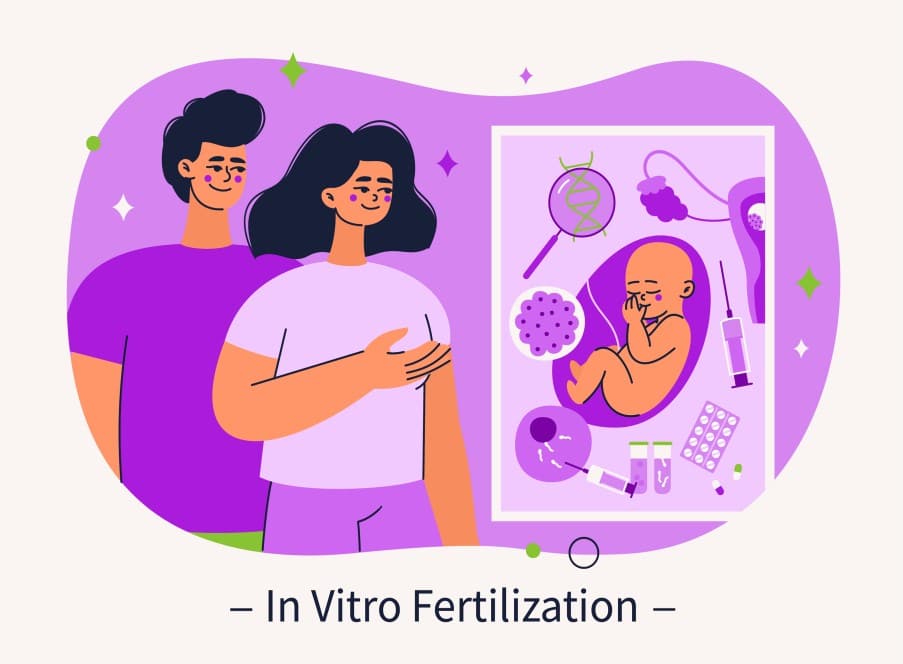Starting a family and embracing motherhood are dreams many women hold dear. However, life’s twists and turns sometimes lead women to consider sterilization, such as tubal ligation, where the fallopian tubes are cut and tied to prevent pregnancy permanently. Yet, as time passes, desires can change; some women may yearn for a child or a sibling for their kids. In such moments, the journey becomes complex, and many find themselves navigating two options: tubal ligation reversal and/or in vitro fertilization (IVF). Each path comes with its own set of challenges and benefits, making the decision a significant one.

£ 5,500 starting price
Tubal Ligation Reversal in the UK

£ 3,500 (All Inclusive)
Tubal Ligation Reversal with KCM Clinic
In this article, we will explore the topic of pregnancy after tubal ligation reversal, the pros and cons of tubal ligation reversal and IVF, and much more!
Understanding Tubal Ligation Reversal And IVF
An operation known as a tubal ligation involves tying and severing the fallopian tubes to prevent conception. The fallopian tubes are blocked by a tubal ligation, preventing the union of an egg and sperm. As a result, fertilization becomes difficult. Surgery to reverse a tubal ligation is known as tubal ligation reversal. A tubal ligation reversal reopens or reconnects the fallopian tubes, allowing the fusion of sperm and eggs and facilitating conception and subsequent pregnancy.
Conversely, in vitro fertilization (IVF) a form of assisted reproduction technology (ART), involves a process in which an egg and sperm are fertilized outside of the human body. Eggs are retrieved from ovaries and combined with sperm in a laboratory for conception. The fertilized egg, which is now known as an embryo, is inserted into a uterus a few days following fertilization. This embryo inserts itself into the uterine wall and leads to pregnancy.
Pros And Cons Of Tubal Ligation Reversal For Pregnancy
Pros:
- Allows for the possibility of becoming pregnant naturally after the procedure.
- Less expensive than in vitro fertilization (IVF).
- Involves surgical reconnection of the tubes, at the same time avoids hormonal treatments and medication.
- Restores the natural way of conceiving.
- It can provide the option of multiple pregnancies over time.
Cons:
- Success rates can differ based on individual factors such as age and the method of original ligation.
- Risks associated with tubal ligation reversal procedure, includes infection, bleeding, or damage to surrounding organs.
- Pregnancy is not guaranteed even if the tubes are successfully reconnected; other fertility factors may be at play.
- Requires a recovery period during which conception is not possible.
Pros And Cons Of IVF For Pregnancy
Pros:
- It enables couples to plan when to conceive, which can be beneficial for personal reasons.
- IVF is effective for many causes of infertility, including hormonal imbalances.
Cons:
- IVF can be financially burdensome, especially if multiple cycles are needed.
- The IVF process involves numerous appointments, tests, and procedures, which can be time-consuming.
- The experience of IVF can lead to stress and anxiety due to the uncertainty of outcomes.
- The procedure involves medical procedures like egg retrieval and embryo transfer, which can be uncomfortable or painful.
Tubal Reversal vs. IVF
When comparing tubal ligation reversal and IVF, several factors come into play. Over the years, success rates for IVF have improved, and high-quality IVF clinics are increasingly accessible to prospective parents. The IVF process involves retrieving eggs from the ovaries and fertilizing them with sperm in a lab. After culturing the fertilized eggs and embryos for a few days, a viable embryo can be implanted back into the uterus, where it can attach to the uterine wall and develop into a healthy baby.
Many women who have had tubal ligation prefer IVF because it’s usually safer and less invasive than surgery to reverse the procedure. Another benefit of IVF is that after having a baby, parents can avoid the risk of unintended pregnancies since the fallopian tubes remain blocked. This provides a sense of control over family planning and reduces concerns about future pregnancies.
Why Tubal Ligation Reversal Can Be Preferable To IVF
Tubal ligation reversal can be a better option than IVF for women wanting to conceive after sterilization. This procedure reconnects the fallopian tubes, allowing for natural conception without the hormonal treatments and complex procedures associated with IVF. Women who undergo reversal may experience the joy of multiple pregnancies without additional medical interventions. Moreover, this approach can provide a sense of control over family planning, as it restores the body’s natural reproductive function, making it a preferred choice for those seeking to expand their families.
The Final Word
When considering tubal ligation reversal versus IVF, the best choice varies by individual circumstances and goals. Tubal ligation reversal allows for the possibility of natural conception and may enable multiple pregnancies, which is appealing for many women, in case they plan to expand their family in the future. Conversely, IVF is often more suitable for those with complex fertility issues or for whom reversal isn’t feasible. Each option has its own set of benefits and challenges, making it essential to consult with a fertility expert to evaluate personal medical history and preferences. Ultimately, the decision should align with one’s family planning aspirations and overall reproductive health.
References:
- https://my.clevelandclinic.org/health/treatments/17584-tubal-ligation-reversal
- https://www.mayoclinic.org/tests-procedures/tubal-ligation/about/pac-20388360
- https://www.mayoclinic.org/healthy-lifestyle/birth-control/multimedia/illustration-of-tubal-ligation-reversal/img-20007200
- https://www.hopkinsmedicine.org/health/treatment-tests-and-therapies/tubal-ligation
- https://www.mayoclinic.org/tests-procedures/in-vitro-fertilization/about/pac-20384716
- https://medlineplus.gov/ency/article/007279.htm
- https://my.clevelandclinic.org/health/treatments/22457-ivf
- https://www.ncbi.nlm.nih.gov/pmc/articles/PMC8524733/








